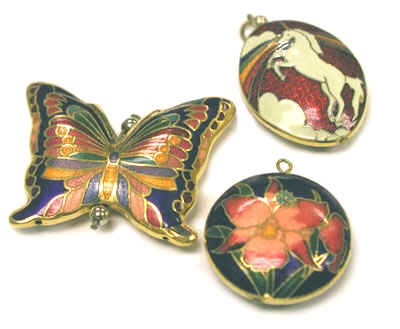Cloisonné Jewelry (ca. 1980)

The first step in the production of cloisonné is to form an outline of the desired image with a gold wire or ribbon. An enamel paste, which consists of a fine glass powder mixed with water, is poured into the spaces (cells) formed by the wire. The glass is then melted by heating it at temperatures up to 850 degrees C. When it cools, a hard glass enamel results.
The various colors are due to the metallic oxides that have been added to the enamel. In the past, some manufacturers in Taiwan employed uranium oxide to produce an ivory, yellow or gold color.
In January of 1983, the New York State Department of Health issued a press release warning that some pieces of yellow-orange and off-white (beige) cloisonné jewelry were radioactive. This was an accidental discovery made during a statewide search for radioactive gold jewelry that was contaminated with the long-lived decay products of radon. For more information about the radioactive gold, click here.
While it did not consider the cloisonné jewelry a hazard, the state recommended that the public discard it or return it to the place of purchase. After the press release was reported in the January 25, 1983 issue of the New York Times, the matter was taken under consideration by the Nuclear Regulatory Commission. One early course of action taken by the NRC was to contact officials in Taiwan and request that the Taiwanese exporters cease the distribution of cloisonné. According to one report (Courier-Post, February 7, 1983), the radioactive enamel was obtained from Great Britain because it was cheaper than the higher quality material from Japan.
The NRC, having consulted with the Food and Drug Administration and the Consumer Product Safety Commission, concluded that the jewelry represented an unnecessary radiation exposure, and in July of 1983 they eliminated the then-existing exemption that permitted the production and importation of glass enamel that contained not more than 10% by weight source material.
Potential Dose
The NRC estimated that the dose rate to a small area of skin would be approximately 7 mrem/hr due to the wearing of uranium-containing (7%) cloisonné jewelry. They then calculated that the dose to the skin might be 4 rem as a result of wearing this jewelry for 10 hours per week and 52 weeks per year.
Pertinent Regulations
10 CFR 40.13 Unimportant quantities of source material...
(c) Any person is exempt from the regulation in this part and from the requirements for a license set forth in section 62 of the Act to the extent that such person receives, possesses, uses, or transfers:...
(2) Source material contained in the following products:... (iv) Glass enamel or glass enamel frit containing not more than 10 percent by weight source material imported or ordered for importation into the United States, or initially distributed by manufacturers in the United States, before July 25, 1983.
References
- Radiation Exposure of the U.S. Population from Consumer Products and Miscellaneous Sources. NCRP Report No. 95; 1987.
- Nuclear Regulatory Commission. Press Release. NRC Staff Evaluates Cloisonné Jewelry. February 1, 1983.
- Nuclear Regulatory Commission. Systematic Radiological Assessment of Exemptions for Source and Byproduct Materials. NUREG 1717. June 2001.
- Newspaper article. Frederick Post. NRC staff evaluates cloisonne-type jewelry. February 13, 1983.
